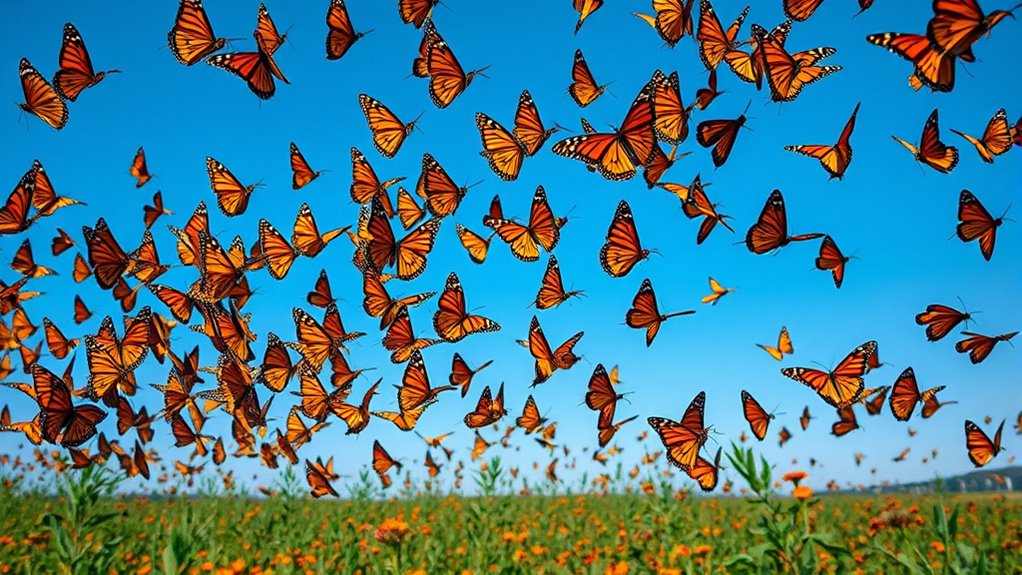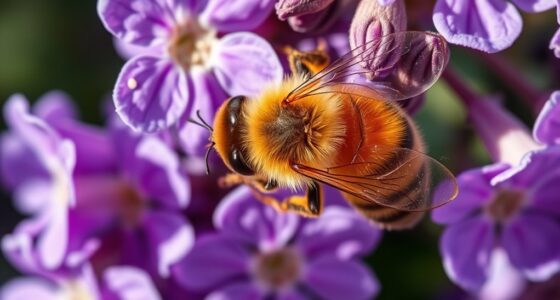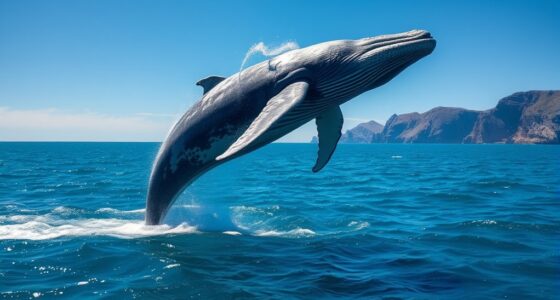Monarch butterfly migration is a delicate and impressive journey that relies on healthy habitats, native plants, and minimal human interference. As you learn about their migration, you’ll see how habitat loss from urban development, pesticides, and agriculture threatens their survival. Creating safe corridors with native milkweed and nectar plants can help support them. Staying informed can reveal how conservation efforts preserve these extraordinary creatures and guarantee that their migration continues for generations to come.
Key Takeaways
- Monarch migration covers thousands of miles, showcasing a remarkable natural phenomenon.
- Milkweed plants are essential for monarch egg-laying and larval nourishment during migration.
- Habitat loss from urbanization, agriculture, and pesticides threatens migration routes and populations.
- Creating native plant corridors with milkweed and nectar sources supports safe travel.
- Habitat conservation efforts are vital for sustaining monarch populations and their delicate migration journey.

Have you ever wondered how monarch butterflies travel thousands of miles each year? Their incredible migration is a marvel of nature, but it’s also a delicate journey filled with challenges. One major obstacle they face is pollination challenges, which directly impact their survival. As monarchs journey across vast distances, they depend heavily on milkweed plants, not only for laying eggs but also for nourishment. Unfortunately, habitat loss due to urban development, agriculture, and pesticide use has led to a significant decline in milkweed availability. This scarcity makes it harder for monarchs to find suitable breeding sites and food sources, further threatening their populations. Guaranteeing habitat conservation becomes vital here; by protecting and restoring native milkweed habitats, we can help ease pollination challenges and sustain their migration. When we conserve these habitats, we’re supporting the pollination process that keeps milkweed and other native plants thriving, creating a healthier environment for monarchs and countless other pollinators. Additionally, fostering conservation practices in efforts can lead to innovative solutions for habitat restoration and protection.
During their migration, monarch butterflies encounter numerous threats that complicate their journey. Habitat fragmentation means they often have to travel longer distances to find suitable breeding grounds, which can exhaust their energy reserves. Pesticides and herbicides used in farming and landscaping pose additional risks; they can poison butterflies directly or eliminate the plants they rely on. These threats make it even more imperative for us to prioritize habitat conservation efforts. By planting native milkweed and nectar-rich flowers in gardens, parks, and roadside areas, you can help create corridors that facilitate their movement and provide essential resources. Such efforts not only support pollination but also guarantee that monarchs have safe routes to travel during their migrations. Moreover, understanding pollination ecology can help us develop better strategies to support and restore vital habitats for migrating monarchs. Recognizing the ecological significance of pollinators underscores the importance of mitigating these threats to maintain ecosystem health.
The decline in habitat quality and pollination challenges also disrupts the ecological balance. Monarchs are part of a larger pollination network that sustains various plant species, which in turn support other wildlife. When their habitats are compromised, it triggers a chain reaction that affects biodiversity and ecosystem health. Your role in habitat conservation can be significant. Simple actions like planting milkweed and avoiding pesticide use can make a difference. By doing so, you’re helping to overcome pollination challenges and contributing to the preservation of this incredible migration. Protecting habitats is not just about saving monarch butterflies; it’s about maintaining the natural systems that sustain life. Their journey is a reminder of our responsibility to care for the environment, ensuring future generations can marvel at their stunning migration.
Frequently Asked Questions
How Do Monarchs Navigate During Migration Without GPS?
You might wonder how monarchs navigate during migration without GPS. They rely on natural cues like magnetic navigation and celestial cues from the sun and stars. These butterflies sense Earth’s magnetic field, helping them maintain direction, while their ability to read the sun’s position guides them during the day. Together, these sophisticated mechanisms enable monarchs to undertake their incredible, delicate journey across vast distances.
What Triggers Monarch Butterflies to Start Their Migration?
You might wonder what triggers monarch butterflies to start their migration. It’s mainly driven by changes in temperature, daylight, and monarch breeding habits. As days get shorter and temperatures drop, they sense it’s time to move. Milkweed importance plays a role, too, since it’s essential for their breeding. When conditions signal the season is changing, monarchs begin their journey to warmer areas, ensuring their survival and continued migration cycle.
How Long Can Monarch Butterflies Live During Migration?
Imagine a fragile monarch fluttering through endless skies; during migration, its lifespan extends far beyond typical months. You might not realize it, but the monarch’s migration duration can last up to eight months, allowing it to survive the long journey. This extraordinary lifespan showcases nature’s resilience, as these butterflies endure through changing seasons, making their journey a remarkable demonstration of survival and adaptation in the wild.
Do Monarchs Migrate Alone or in Groups?
You might wonder if monarchs migrate alone or in groups. During migration, monarchs display group dynamics rather than solitary behavior. They often travel together in large clusters, especially in the warmer months, which helps protect them from predators and aids navigation. While they sometimes fly solo, especially outside migration periods, their journey is mostly a group effort, showcasing the importance of social behavior in their remarkable migration.
How Does Climate Change Affect Monarch Migration Patterns?
Climate impact profoundly affects monarch migration patterns, causing delays and disruptions. You might notice that warmer temperatures and unpredictable weather alter their usual routes and timing. These changes can lead to migration delays, making it harder for monarchs to reach their breeding grounds or overwintering sites. By understanding this, you can help support efforts to mitigate climate change and protect these delicate journeys.
Conclusion
As you watch the monarchs’ graceful flight, remember they symbolize resilience and hope. Their delicate journey reminds you that even in fragile moments, strength is born from perseverance. Like the butterfly’s migration, your own path may be uncertain, but with patience and courage, you’ll find your way. Embrace the symbolism of these tiny travelers, for they show that transformation and renewal are always within reach—if you’re willing to follow your own wings.








